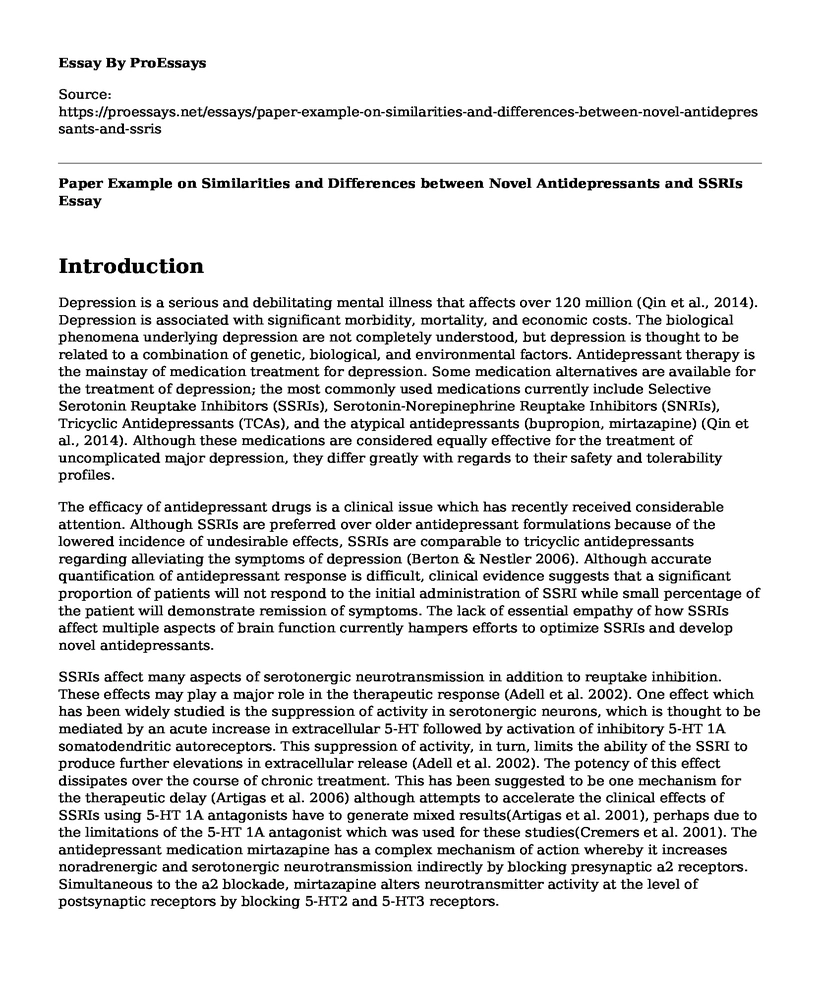Introduction
Depression is a serious and debilitating mental illness that affects over 120 million (Qin et al., 2014). Depression is associated with significant morbidity, mortality, and economic costs. The biological phenomena underlying depression are not completely understood, but depression is thought to be related to a combination of genetic, biological, and environmental factors. Antidepressant therapy is the mainstay of medication treatment for depression. Some medication alternatives are available for the treatment of depression; the most commonly used medications currently include Selective Serotonin Reuptake Inhibitors (SSRIs), Serotonin-Norepinephrine Reuptake Inhibitors (SNRIs), Tricyclic Antidepressants (TCAs), and the atypical antidepressants (bupropion, mirtazapine) (Qin et al., 2014). Although these medications are considered equally effective for the treatment of uncomplicated major depression, they differ greatly with regards to their safety and tolerability profiles.
The efficacy of antidepressant drugs is a clinical issue which has recently received considerable attention. Although SSRIs are preferred over older antidepressant formulations because of the lowered incidence of undesirable effects, SSRIs are comparable to tricyclic antidepressants regarding alleviating the symptoms of depression (Berton & Nestler 2006). Although accurate quantification of antidepressant response is difficult, clinical evidence suggests that a significant proportion of patients will not respond to the initial administration of SSRI while small percentage of the patient will demonstrate remission of symptoms. The lack of essential empathy of how SSRIs affect multiple aspects of brain function currently hampers efforts to optimize SSRIs and develop novel antidepressants.
SSRIs affect many aspects of serotonergic neurotransmission in addition to reuptake inhibition. These effects may play a major role in the therapeutic response (Adell et al. 2002). One effect which has been widely studied is the suppression of activity in serotonergic neurons, which is thought to be mediated by an acute increase in extracellular 5-HT followed by activation of inhibitory 5-HT 1A somatodendritic autoreceptors. This suppression of activity, in turn, limits the ability of the SSRI to produce further elevations in extracellular release (Adell et al. 2002). The potency of this effect dissipates over the course of chronic treatment. This has been suggested to be one mechanism for the therapeutic delay (Artigas et al. 2006) although attempts to accelerate the clinical effects of SSRIs using 5-HT 1A antagonists have to generate mixed results(Artigas et al. 2001), perhaps due to the limitations of the 5-HT 1A antagonist which was used for these studies(Cremers et al. 2001). The antidepressant medication mirtazapine has a complex mechanism of action whereby it increases noradrenergic and serotonergic neurotransmission indirectly by blocking presynaptic a2 receptors. Simultaneous to the a2 blockade, mirtazapine alters neurotransmitter activity at the level of postsynaptic receptors by blocking 5-HT2 and 5-HT3 receptors.
Conclusion
In conclusion, some medications including SSRIs, SNRIs, and other antidepressant medications have demonstrated efficacy for the treatment of depression. SSRs is extensively recommended as the first line administration for depression because of the broad efficacy and safety of these drugs. SSRI administration immediately triggers multiple physiological responses in the brain, for example, the suppression of activity in serotonergic neurons via activation of inhibitory autoreceptors. Many of these effects dissipate upon chronic treatment, and this adaptation may be essential for the favorable effects of antidepressants to emerge following the therapeutic delay period. As a first step in understanding how 5-HT synthesis rate might be involved in SSRI efficacy, it is critical to determine the effect of SSRIs, administered chronically and continuously as inpatients, on 5-HT synthesis rate.
References
Adell, A, Celada, P, Teresa Abellan, M, & Artigas, F., (2002). Origin and functional role of the extracellular serotonin in the midbrain raphe nuclei. Brain Res Rev 39: 154-180.
Artigas F, Adell A., & Celada P. (2006) Pindolol augmentation of antidepressant response. Current drug targets, 7(2):139-47
Berton, O. & Nestler E., J. (2006). New approaches to antidepressant drug discovery: Beyond monoamines. Nat Rev Neurosci. 7(2): 137-151.
Cremers, T.I., Wiersma, L.J., Bosker, F.J., den Boer, J.A., Westrink, B.H., & Wikstrom, H.V. (2001). Is the beneficial antidepressant effect of coadministration of pindolol really due to somatodendritic autoreceptor antagonism? Biol Psychiatr, 50(1):13-21.
Qin, B., Zhang, Y., Zhou, X., Cheng, P., Liu, Y., Chen, J., ... & Xie, P. (2014). Selective serotonin reuptake inhibitors versus tricyclic antidepressants in young patients: a meta-analysis of efficacy and acceptability. Clinical Therapeutics, 36(7), 1087-1095
Cite this page
Paper Example on Similarities and Differences between Novel Antidepressants and SSRIs. (2022, Jul 11). Retrieved from https://proessays.net/essays/paper-example-on-similarities-and-differences-between-novel-antidepressants-and-ssris
If you are the original author of this essay and no longer wish to have it published on the ProEssays website, please click below to request its removal:
- The Morality of Suicide: The Divergent and Convergent Views
- Celebrating the Strengths of Black Youth: Increasing Self-Esteem and Implications for Prevention
- Essay Sample on Schizophrenia: Assessment, and Treatment
- The Influence of Stress and Exhaustion on Body Cells and Muscles Essay
- Essay Example on Law Enforcement: Dealing With Mental Illness Crisis
- Every Individual Unique: Traits, Culture & Personality - Essay Sample
- Essay Example on Depression & Anxiety: Different Conditions, Common Symptoms







